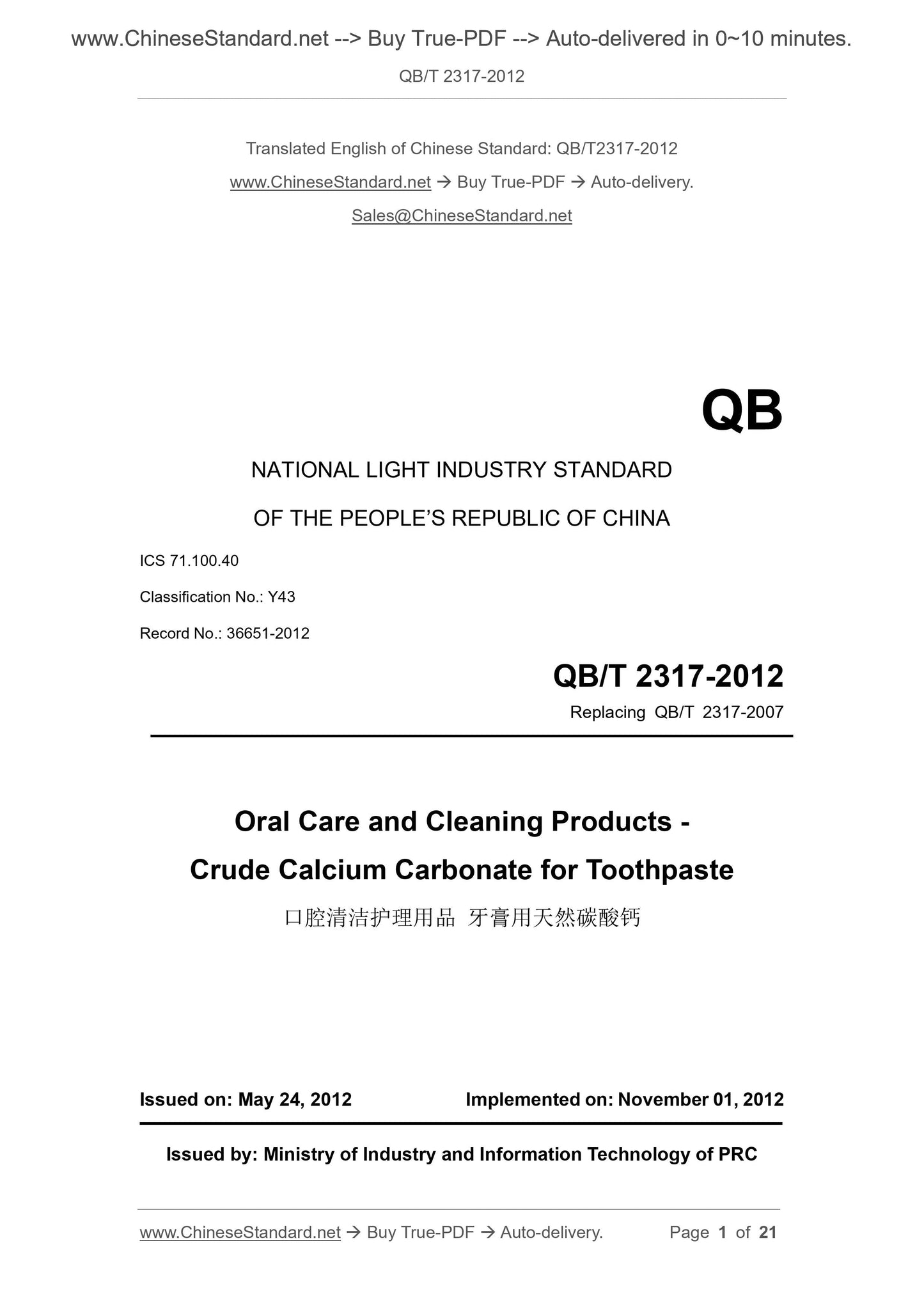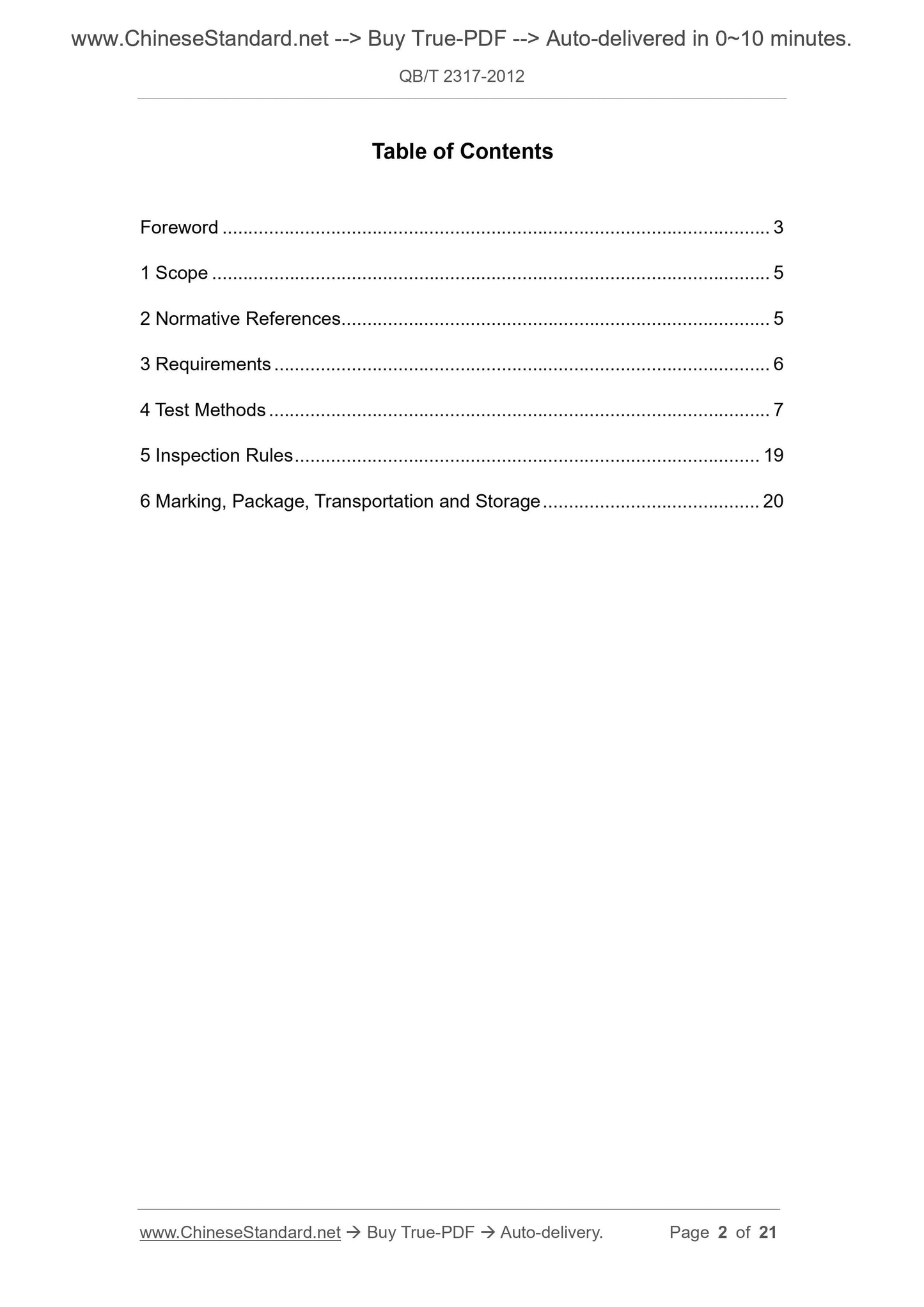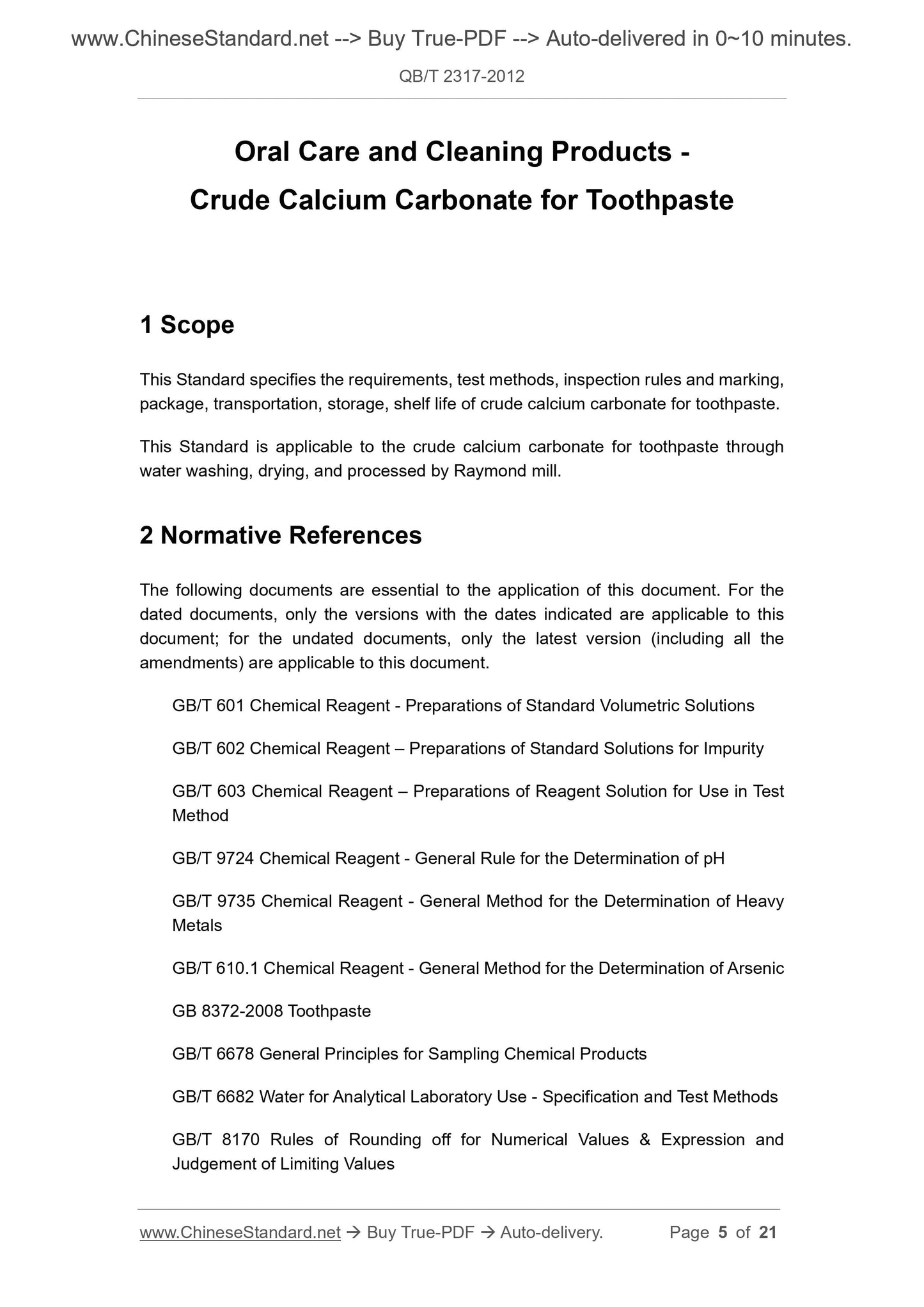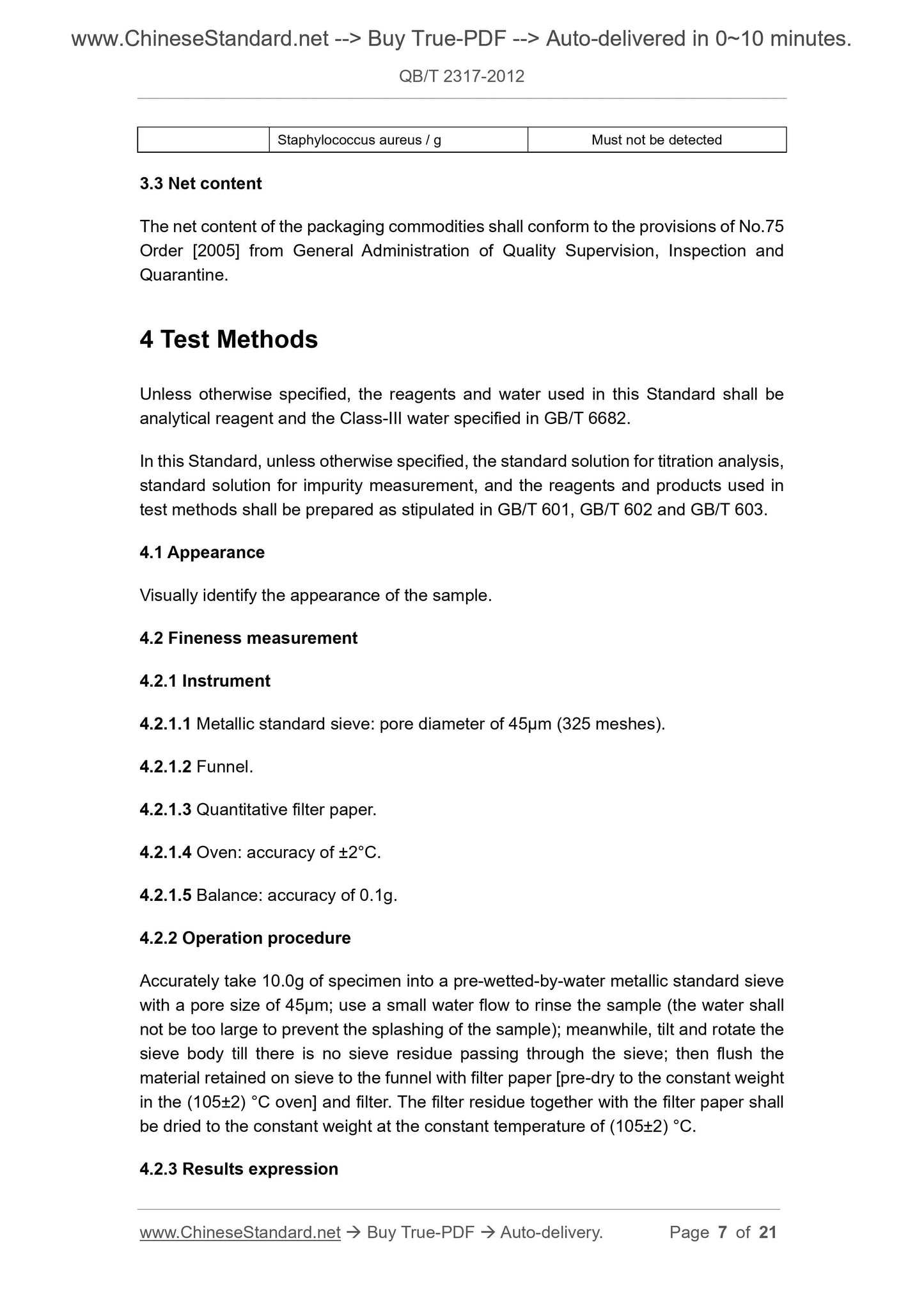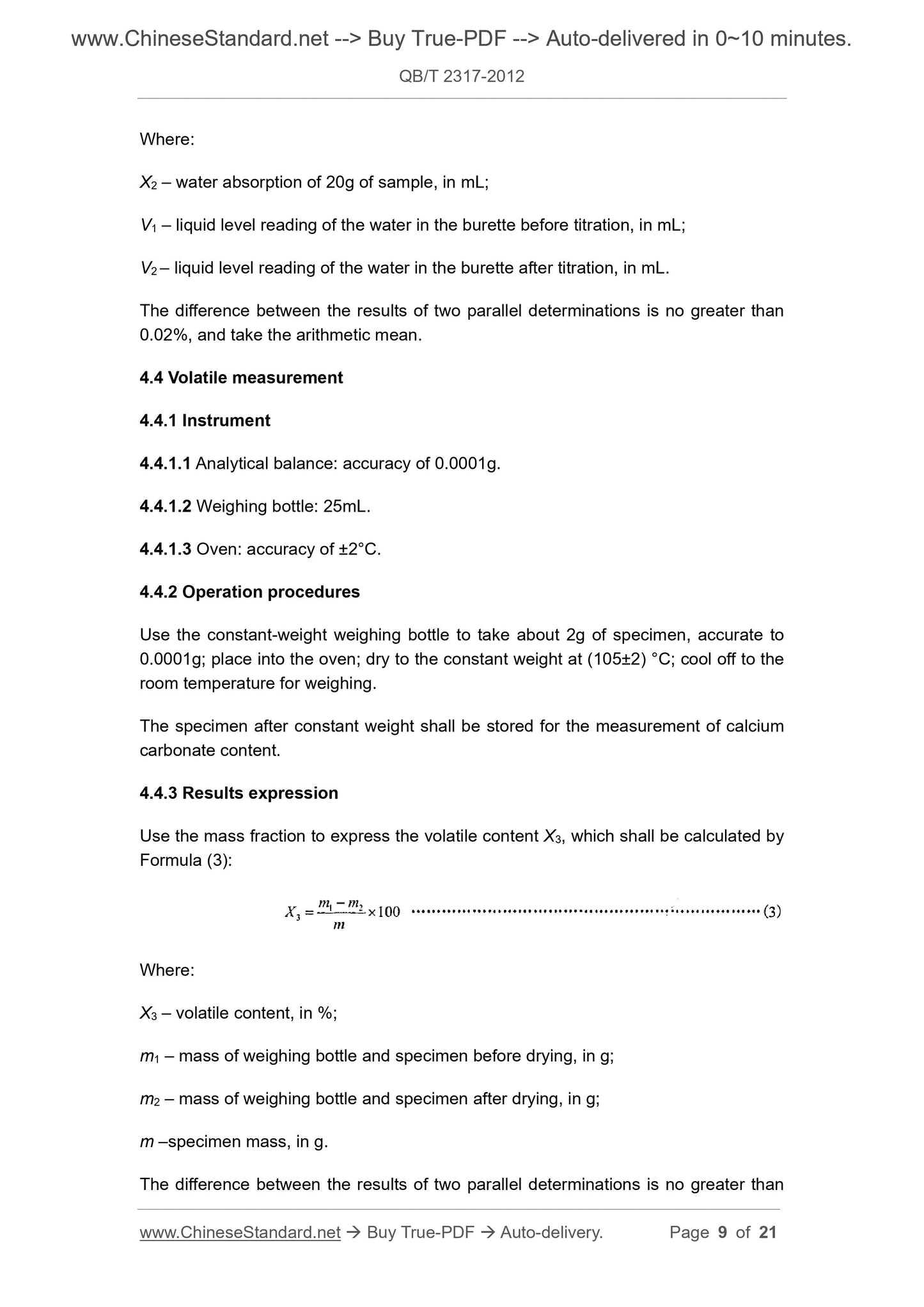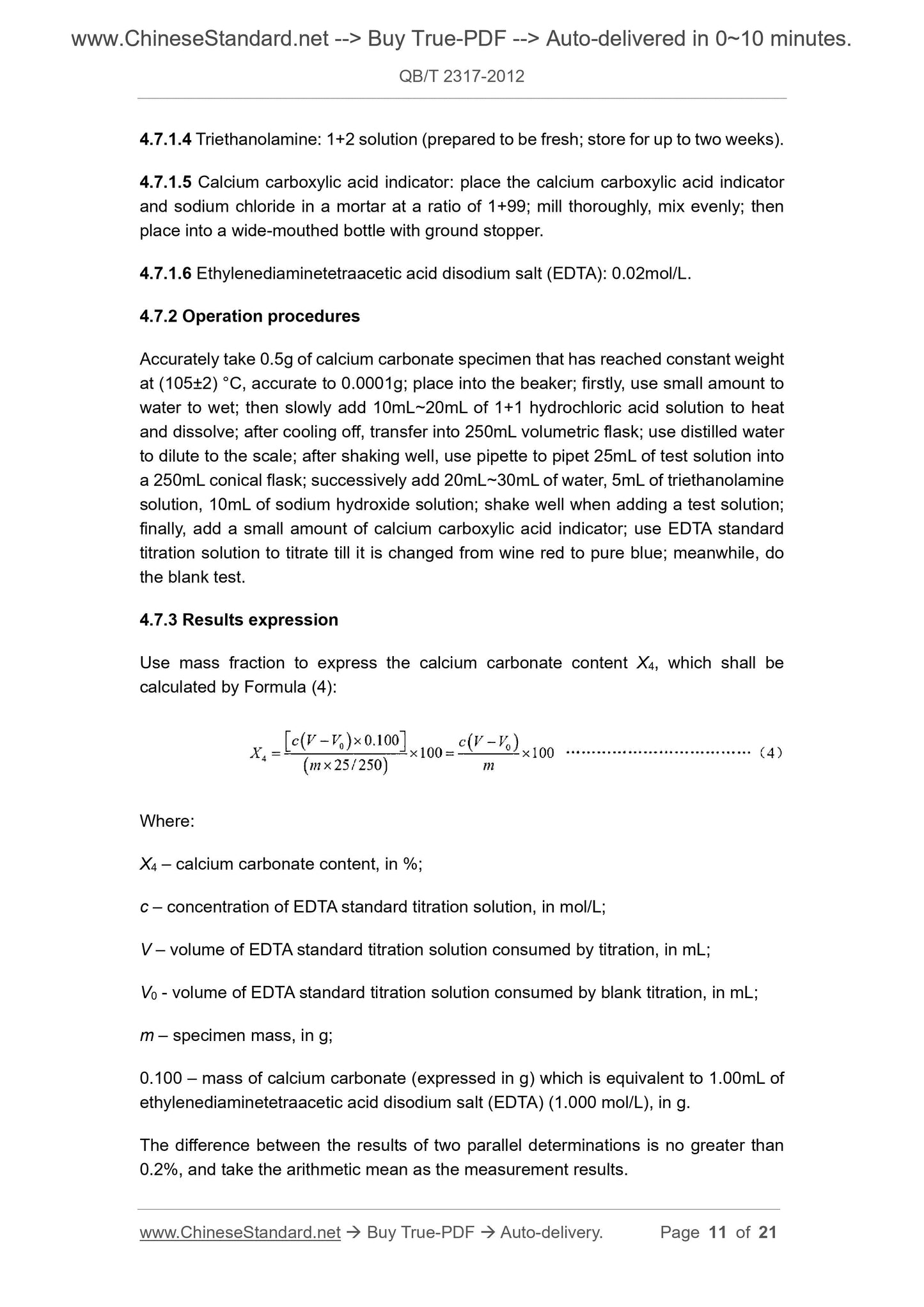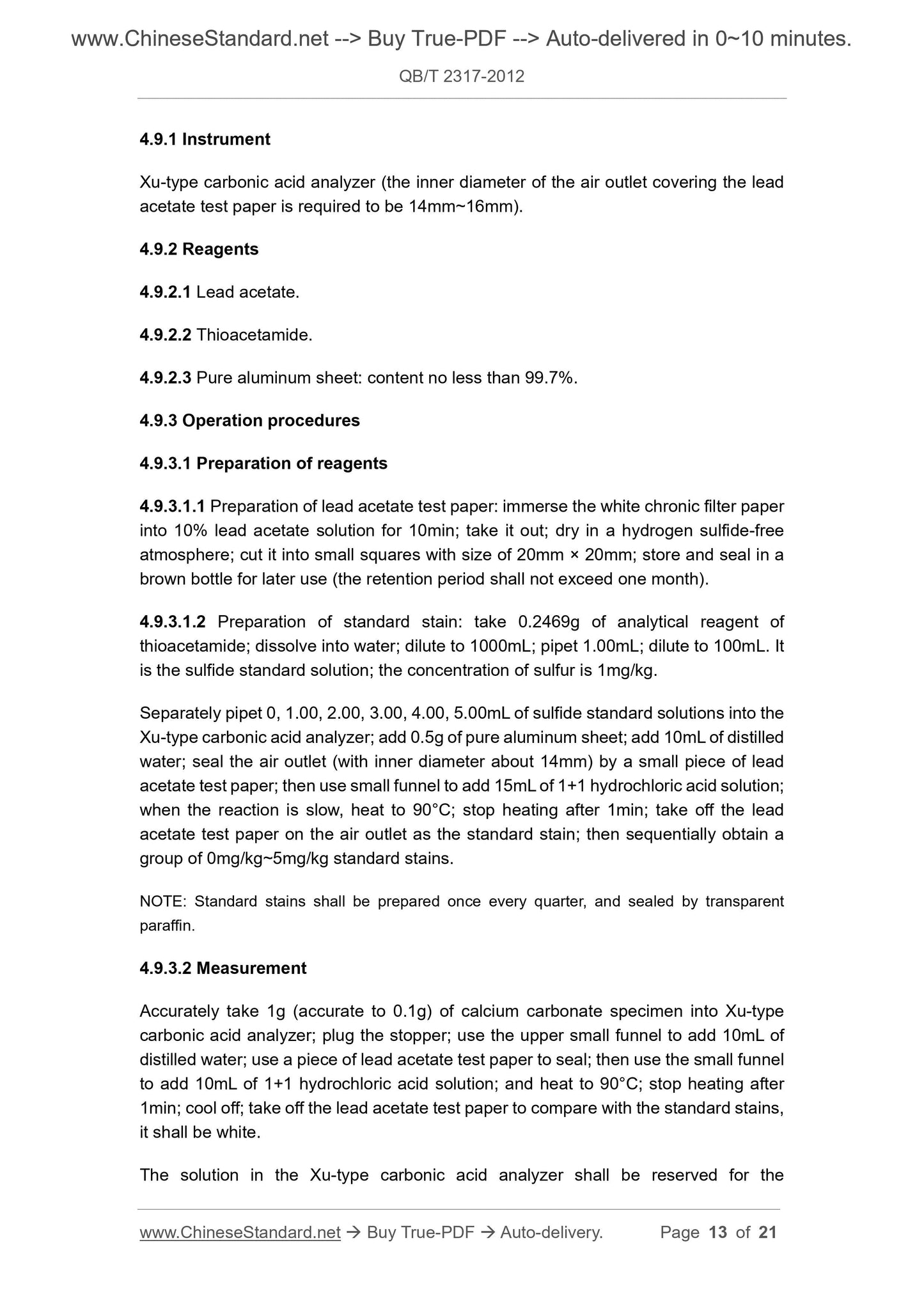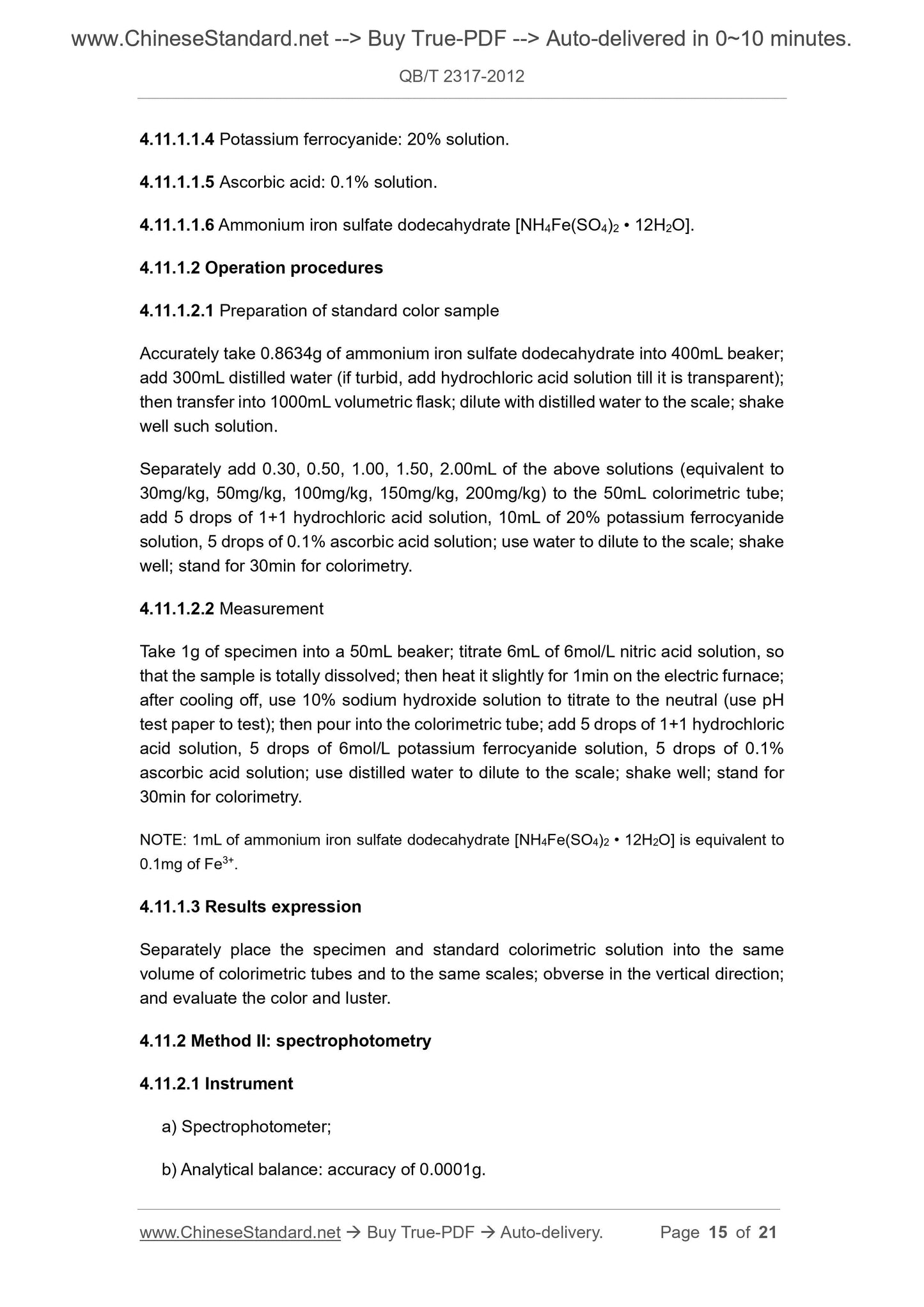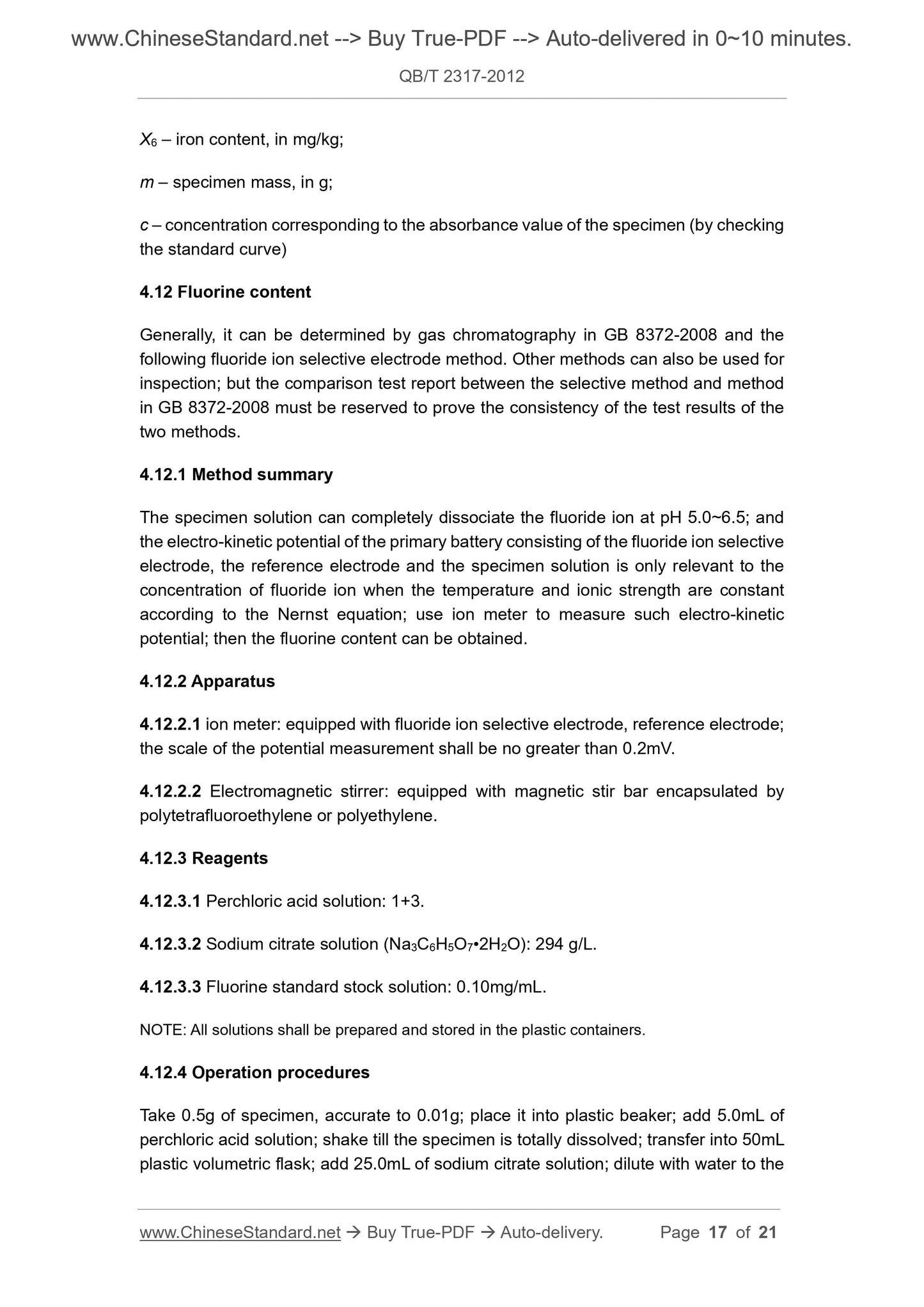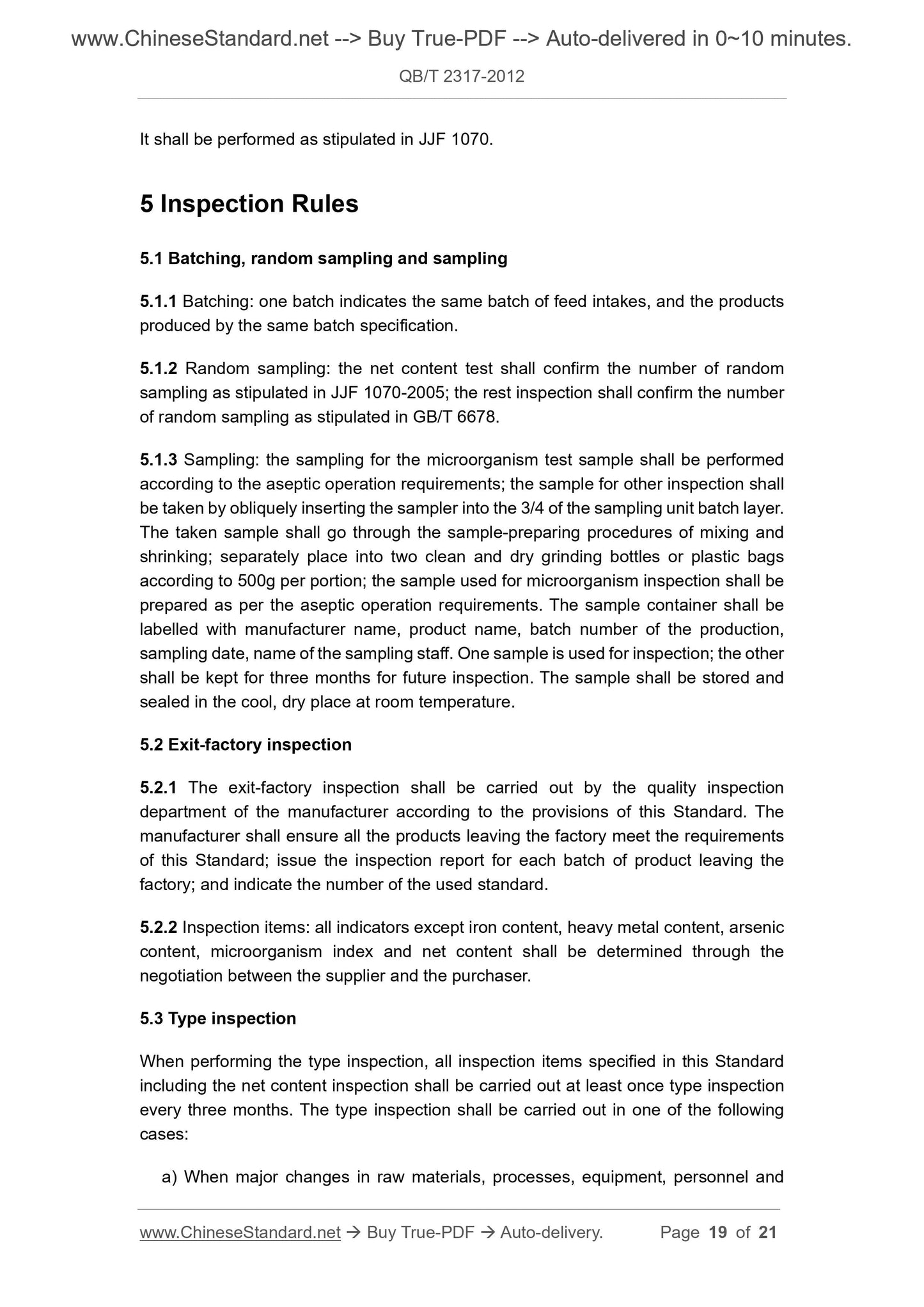1
/
of
10
www.ChineseStandard.us -- Field Test Asia Pte. Ltd.
QB/T 2317-2012 English PDF (QB/T2317-2012)
QB/T 2317-2012 English PDF (QB/T2317-2012)
Regular price
$105.00
Regular price
Sale price
$105.00
Unit price
/
per
Shipping calculated at checkout.
Couldn't load pickup availability
QB/T 2317-2012: Oral Care and Cleaning Products - Crude Calcium Carbonate for Toothpaste
Delivery: 9 seconds. Download (& Email) true-PDF + Invoice.
Get Quotation: Click QB/T 2317-2012 (Self-service in 1-minute)
Historical versions (Master-website): QB/T 2317-2012
Preview True-PDF (Reload/Scroll-down if blank)
QB/T 2317-2012
NATIONAL LIGHT INDUSTRY STANDARD
OF THE PEOPLE’S REPUBLIC OF CHINA
ICS 71.100.40
Classification No.: Y43
Record No.: 36651-2012
Replacing QB/T 2317-2007
Oral Care and Cleaning Products -
Crude Calcium Carbonate for Toothpaste
ISSUED ON: MAY 24, 2012
IMPLEMENTED ON: NOVEMBER 01, 2012
Issued by: Ministry of Industry and Information Technology of PRC
Table of Contents
Foreword ... 3
1 Scope ... 5
2 Normative References ... 5
3 Requirements ... 6
4 Test Methods ... 7
5 Inspection Rules ... 19
6 Marking, Package, Transportation and Storage ... 20
Oral Care and Cleaning Products -
Crude Calcium Carbonate for Toothpaste
1 Scope
This Standard specifies the requirements, test methods, inspection rules and marking,
package, transportation, storage, shelf life of crude calcium carbonate for toothpaste.
This Standard is applicable to the crude calcium carbonate for toothpaste through
water washing, drying, and processed by Raymond mill.
2 Normative References
The following documents are essential to the application of this document. For the
dated documents, only the versions with the dates indicated are applicable to this
document; for the undated documents, only the latest version (including all the
amendments) are applicable to this document.
GB/T 601 Chemical Reagent - Preparations of Standard Volumetric Solutions
GB/T 602 Chemical Reagent – Preparations of Standard Solutions for Impurity
GB/T 603 Chemical Reagent – Preparations of Reagent Solution for Use in Test
Method
GB/T 9724 Chemical Reagent - General Rule for the Determination of pH
GB/T 9735 Chemical Reagent - General Method for the Determination of Heavy
Metals
GB/T 610.1 Chemical Reagent - General Method for the Determination of Arsenic
GB 8372-2008 Toothpaste
GB/T 6678 General Principles for Sampling Chemical Products
GB/T 6682 Water for Analytical Laboratory Use - Specification and Test Methods
GB/T 8170 Rules of Rounding off for Numerical Values and Expression and
Judgement of Limiting Values
Staphylococcus aureus / g Must not be detected
3.3 Net content
The net content of the packaging commodities shall conform to the provisions of No.75
Order [2005] from General Administration of Quality Supervision, Inspection and
Quarantine.
4 Test Methods
Unless otherwise specified, the reagents and water used in this Standard shall be
analytical reagent and the Class-III water specified in GB/T 6682.
In this Standard, unless otherwise specified, the standard solution for titration analysis,
standard solution for impurity measurement, and the reagents and products used in
test methods shall be prepared as stipulated in GB/T 601, GB/T 602 and GB/T 603.
4.1 Appearance
Visually identify the appearance of the sample.
4.2 Fineness measurement
4.2.1 Instrument
4.2.1.1 Metallic standard sieve: pore diameter of 45µm (325 meshes).
4.2.1.2 Funnel.
4.2.1.3 Quantitative filter paper.
4.2.1.4 Oven: accuracy of ±2°C.
4.2.1.5 Balance: accuracy of 0.1g.
4.2.2 Operation procedure
Accurately take 10.0g of specimen into a pre-wetted-by-water metallic standard sieve
with a pore size of 45µm; use a small water flow to rinse the sample (the water shall
not be too large to prevent the splashing of the sample); meanwhile, tilt and rotate the
sieve body till there is no sieve residue passing through the sieve; then flush the
material retained on sieve to the funnel with filter paper [pre-dry to the constant weight
in the (105±2) °C oven] and filter. The filter residue together with the filter paper shall
be dried to the constant weight at the constant temperature of (105±2) °C.
4.2.3 Results expression
Where:
X2 – water absorption of 20g of sample, in mL;
V1 – liquid level reading of the water in the burette before titration, in mL;
V2 – liquid level reading of the water in the burette after titration, in mL.
The difference between the results of two parallel determinations is no greater than
0.02%, and take the arithmetic mean.
4.4 Volatile measurement
4.4.1 Instrument
4.4.1.1 Analytical balance: accuracy of 0.0001g.
4.4.1.2 Weighing bottle: 25mL.
4.4.1.3 Oven: accuracy of ±2°C.
4.4.2 Operation procedures
Use the constant-weight weighing bottle to take about 2g of specimen, accurate to
0.0001g; place into the oven; dry to the constant weight at (105±2) °C; cool off to the
room temperature for weighing.
The specimen after constant weight shall be stored for the measurement of calcium
carbonate content.
4.4.3 Results expression
Use the mass fraction to express the volatile content X3, which shall be calculated by
Formula (3):
Where:
X3 – volatile content, in %;
m1 – mass of weighing bottle and specimen before drying, in g;
m2 – mass of weighing bottle and specimen after drying, in g;
m –specimen mass, in g.
The difference between the results of two parallel determinations is no greater than
4.7.1.4 Triethanolamine: 1+2 solution (prepared to be fresh; store for up to two weeks).
4.7.1.5 Calcium carboxylic acid indicator: place the calcium carboxylic acid indicator
and sodium chloride in a mortar at a ratio of 1+99; mill thoroughly, mix evenly; then
place into a wide-mouthed bottle with ground stopper.
4.7.1.6 Ethylenediaminetetraacetic acid disodium salt (EDTA): 0.02mol/L.
4.7.2 Operation procedures
Accurately take 0.5g of calcium carbonate specimen that has reached constant weight
at (105±2) °C, accurate to 0.0001g; place into the beaker; firstly, use small amount to
water to wet; then slowly add 10mL~20mL of 1+1 hydrochloric acid solution to heat
and dissolve; after cooling off, transfer into 250mL volumetric flask; use distilled water
to dilute to the scale; after shaking well, use pipette to pipet 25mL of test solution into
a 250mL conical flask; successively add 20mL~30mL of water, 5mL of triethanolamine
solution, 10mL of sodium hydroxide solution; shake well when adding a test solution;
finally, add a small amount of calcium carboxylic acid indicator; use EDTA standard
titration solution to titrate till it is changed from wine red to pure blue; meanwhile, do
the blank test.
4.7.3 Results expression
Use mass fraction to express the calcium carbonate content X4, which shall be
calculated by Formula (4):
Where:
X4 – calcium carbonate content, in %;
c – concentration of EDTA standard titration solution, in mol/L;
V – volume of EDTA standard titration solution consumed by titration, in mL;
V0 - volume of EDTA standard titration solution consumed by blank titration, in mL;
m – specimen mass, in g;
0.100 – mass of calcium carbonate (expressed in g) which is equivalent to 1.00mL of
ethylenediaminetetraacetic acid disodium salt (EDTA) (1.000 mol/L), in g.
The difference between the results of two parallel determinations is no greater than
0.2%, and take the arithmetic mean as the measurement results.
4.9.1 Instrument
Xu-type carbonic acid analyzer (the inner diameter of the air outlet covering the lead
acetate test paper is required to be 14mm~16mm).
4.9.2 Reagents
4.9.2.1 Lead acetate.
4.9.2.2 Thioacetamide.
4.9.2.3 Pure aluminum sheet: content no less than 99.7%.
4.9.3 Operation procedures
4.9.3.1 Preparation of reagents
4.9.3.1.1 Preparation of lead acetate test paper: immerse the white chronic filter paper
into 10% lead acetate solution for 10min; take it out; dry in a hydrogen sulfide-free
atmosphere; cut it into small squares with size of 20mm × 20mm; store and seal in a
brown bottle for later use (the retention period shall not exceed one month).
4.9.3.1.2 Preparation of standard stain: take 0.2469g of analytical reagent of
thioacetamide; dissolve into water; dilute to 1000mL; pipet 1.00mL; dilute to 100mL. It
is the sulfide standard solution; the concentration of sulfur is 1mg/kg.
Separately pipet 0, 1.00, 2.00, 3.00, 4.00, 5.00mL of sulfide standard solutions into the
Xu-type carbonic acid analyzer; add 0.5g of pure aluminum sheet; add 10mL of distilled
water; seal the air outlet (with inner diameter about 14mm) by a small piece of lead
acetate test paper; then use small funnel to add 15mL of 1+1 hydrochloric acid solution;
when the reaction is slow, heat to 90°C; stop heating after 1min; take off the lead
acetate test paper on the air outlet as the standard stain; then sequentially obtain a
group of 0mg/kg~5mg/kg standard stains.
NOTE: Standard stains shall be prepared once every quarter, and sealed by transparent
paraffin.
4.9.3.2 Measurement
Accurately take 1g (accurate to 0.1g) of calcium carbonate specimen into Xu-type
carbonic acid analyzer; plug the stopper; use the upper small funnel to add 10mL of
distilled water; use a piece of lead acetate test paper to seal; then use the small funnel
to add 10mL of 1+1 hydrochloric acid solution; and heat to 90°C; stop heating after
1min; cool off; take off the lead acetate test paper to compare with the standard stains,
it shall be white.
The solution in the Xu-type carbonic acid analyzer shall be reserved for the
4.11.1.1.4 Potassium ferrocyanide: 20% solution.
4.11.1.1.5 Ascorbic acid: 0.1% solution.
4.11.1.1.6 Ammonium iron sulfate dodecahydrate [NH4Fe(SO4)2 • 12H2O].
4.11.1.2 Operation procedures
4.11.1.2.1 Preparation of standard color sample
Accurately take 0.8634g of ammonium iron sulfate dodecahydrate into 400mL beaker;
add 300mL distilled water (if turbid, add hydrochloric acid solution till it is transparent);
then transfer into 1000mL volumetric flask; dilute with distilled water to the scale; shake
well such solution.
Separately add 0.30, 0.50, 1.00, 1.50, 2.00mL of the above solutions (equivalent to
30mg/kg, 50mg/kg, 100mg/kg, 150mg/kg, 200mg/kg) to the 50mL colorimetric tube;
add 5 drops of 1+1 hydrochloric acid solution, 10mL of 20% potassium ferrocyanide
solution, 5 drops of 0.1% ascorbic acid solution; use water to dilute to the scale; shake
well; stand for 30min for colorimetry.
4.11.1.2.2 Measurement
Take 1g of specimen into a 50mL beaker; titrate 6mL of 6mol/L nitric acid solution, so
that the sample is totally dissolved; then heat it slightly for 1min on the electric furnace;
after cooling off, use 10% sodium hydroxide solution to titrate to the neutral (use pH
test paper to test); then pour into the colorimetric tube; add 5 drops of 1+1 hydrochloric
acid solution, 5 drops of 6mol/L potassium ferrocyanide solution, 5 drops of 0.1%
ascorbic acid solution; use distilled water to dilute to the scale; shake well; stand for
30min for colorimetry.
NOTE: 1mL of ammonium iron sulfate dodecahydrate [NH4Fe(SO4)2 • 12H2O] is equivalent to
0.1mg of Fe3+.
4.11.1.3 Results expression
Separately place the specimen and standard colorimetric solution into the same
volume of colorimetric tubes and to the same scales; obverse in the vertical direction;
and evaluate the color and luster.
4.11.2 Method II: spectrophotometry
4.11.2.1 Instrument
a) Spectrophotometer;
b) Analytical balance: accuracy of 0.0001g.
X6 – iron content, in mg/kg;
m – specimen mass, in g;
c – concentration corresponding to the absorbance value of the specimen (by checking
the standard curve)
4.12 Fluorine content
Generally, it can be determined by gas chromatography in GB 8372-2008 and the
following fluoride ion selective electrode method. Other methods can also be used for
inspection; but the comparison test report between the selective method and method
in GB 8372-2008 must be reserved to prove the consistency of the test results of the
two methods.
4.12.1 Method summary
The specimen solution can completely dissociate the fluoride ion at pH 5.0~6.5; and
the electro-kinetic potential of the primary battery consisting of the fluoride ion selective
electrode, the reference electrode and the specimen solution is only relevant to the
concentration of fluoride ion when the temperature and ionic strength are constant
according to the Nernst equation; use ion meter to measure such electro-kinetic
potential; then the fluorine content can be obtained.
4.12.2 Apparatus
4.12.2.1 ion meter: equipped with fluoride ion selective electrode, reference electrode;
the scale of the potential measurement shall be no greater than 0.2mV.
4.12.2.2 Electromagnetic stirrer: equipped with magnetic stir bar encapsulated by
polytetrafluoroethylene or polyethylene.
4.12.3 Reagents
4.12.3.1 Perchloric acid solution: 1+3.
4.12.3.2 Sodium citrate solution (Na3C6H5O7•2H2O): 294 g/L.
4.12.3.3 Fluorine standard stock solution: 0.10mg/mL.
NOTE: All solutions shall be prepared and stored in the plastic containers.
4.12.4 Operation procedures
Take 0.5g of specimen, accurate to 0.01g; place it into plastic beaker; add 5.0mL of
perchloric acid solution; shake till the specimen is totally dissolved; transfer into 50mL
plastic volumetric flask; add 25.0mL of sodium citrate solution; dilute with water to the
It shall be performed as stipulated in JJF 1070.
5 Inspection Rules
5.1 Batching, random sampling and sampling
5.1.1 Batching: one batch indicates the same batch of feed intakes, and the products
produced by the same batch specification.
5.1.2 Random sampling: the net content test shall confirm the number of random
sampling as stipulated in JJF 1070-2005; the rest inspection shall confirm the number
of random sampling as stipulated in GB/T 6678.
5.1.3 Sampling: the sampling for the microorganism test sample shall be performed
according to the aseptic operation requirements; the sample for other inspection shall
be taken by obliquely inserting the sampler into the 3/4 of the sampling unit batch layer.
The taken sample shall go through the sample-preparing procedures of mixing and
shrinking; separately place into two clean and dry grinding bottles or plastic bags
according to 500g per portion; the sample used for microorganism inspection shall be
prepared as per the aseptic operation requirements. The sample container shall be
labelled with manufacturer name, product name, batch number of the production,
sampling da...
Delivery: 9 seconds. Download (& Email) true-PDF + Invoice.
Get Quotation: Click QB/T 2317-2012 (Self-service in 1-minute)
Historical versions (Master-website): QB/T 2317-2012
Preview True-PDF (Reload/Scroll-down if blank)
QB/T 2317-2012
NATIONAL LIGHT INDUSTRY STANDARD
OF THE PEOPLE’S REPUBLIC OF CHINA
ICS 71.100.40
Classification No.: Y43
Record No.: 36651-2012
Replacing QB/T 2317-2007
Oral Care and Cleaning Products -
Crude Calcium Carbonate for Toothpaste
ISSUED ON: MAY 24, 2012
IMPLEMENTED ON: NOVEMBER 01, 2012
Issued by: Ministry of Industry and Information Technology of PRC
Table of Contents
Foreword ... 3
1 Scope ... 5
2 Normative References ... 5
3 Requirements ... 6
4 Test Methods ... 7
5 Inspection Rules ... 19
6 Marking, Package, Transportation and Storage ... 20
Oral Care and Cleaning Products -
Crude Calcium Carbonate for Toothpaste
1 Scope
This Standard specifies the requirements, test methods, inspection rules and marking,
package, transportation, storage, shelf life of crude calcium carbonate for toothpaste.
This Standard is applicable to the crude calcium carbonate for toothpaste through
water washing, drying, and processed by Raymond mill.
2 Normative References
The following documents are essential to the application of this document. For the
dated documents, only the versions with the dates indicated are applicable to this
document; for the undated documents, only the latest version (including all the
amendments) are applicable to this document.
GB/T 601 Chemical Reagent - Preparations of Standard Volumetric Solutions
GB/T 602 Chemical Reagent – Preparations of Standard Solutions for Impurity
GB/T 603 Chemical Reagent – Preparations of Reagent Solution for Use in Test
Method
GB/T 9724 Chemical Reagent - General Rule for the Determination of pH
GB/T 9735 Chemical Reagent - General Method for the Determination of Heavy
Metals
GB/T 610.1 Chemical Reagent - General Method for the Determination of Arsenic
GB 8372-2008 Toothpaste
GB/T 6678 General Principles for Sampling Chemical Products
GB/T 6682 Water for Analytical Laboratory Use - Specification and Test Methods
GB/T 8170 Rules of Rounding off for Numerical Values and Expression and
Judgement of Limiting Values
Staphylococcus aureus / g Must not be detected
3.3 Net content
The net content of the packaging commodities shall conform to the provisions of No.75
Order [2005] from General Administration of Quality Supervision, Inspection and
Quarantine.
4 Test Methods
Unless otherwise specified, the reagents and water used in this Standard shall be
analytical reagent and the Class-III water specified in GB/T 6682.
In this Standard, unless otherwise specified, the standard solution for titration analysis,
standard solution for impurity measurement, and the reagents and products used in
test methods shall be prepared as stipulated in GB/T 601, GB/T 602 and GB/T 603.
4.1 Appearance
Visually identify the appearance of the sample.
4.2 Fineness measurement
4.2.1 Instrument
4.2.1.1 Metallic standard sieve: pore diameter of 45µm (325 meshes).
4.2.1.2 Funnel.
4.2.1.3 Quantitative filter paper.
4.2.1.4 Oven: accuracy of ±2°C.
4.2.1.5 Balance: accuracy of 0.1g.
4.2.2 Operation procedure
Accurately take 10.0g of specimen into a pre-wetted-by-water metallic standard sieve
with a pore size of 45µm; use a small water flow to rinse the sample (the water shall
not be too large to prevent the splashing of the sample); meanwhile, tilt and rotate the
sieve body till there is no sieve residue passing through the sieve; then flush the
material retained on sieve to the funnel with filter paper [pre-dry to the constant weight
in the (105±2) °C oven] and filter. The filter residue together with the filter paper shall
be dried to the constant weight at the constant temperature of (105±2) °C.
4.2.3 Results expression
Where:
X2 – water absorption of 20g of sample, in mL;
V1 – liquid level reading of the water in the burette before titration, in mL;
V2 – liquid level reading of the water in the burette after titration, in mL.
The difference between the results of two parallel determinations is no greater than
0.02%, and take the arithmetic mean.
4.4 Volatile measurement
4.4.1 Instrument
4.4.1.1 Analytical balance: accuracy of 0.0001g.
4.4.1.2 Weighing bottle: 25mL.
4.4.1.3 Oven: accuracy of ±2°C.
4.4.2 Operation procedures
Use the constant-weight weighing bottle to take about 2g of specimen, accurate to
0.0001g; place into the oven; dry to the constant weight at (105±2) °C; cool off to the
room temperature for weighing.
The specimen after constant weight shall be stored for the measurement of calcium
carbonate content.
4.4.3 Results expression
Use the mass fraction to express the volatile content X3, which shall be calculated by
Formula (3):
Where:
X3 – volatile content, in %;
m1 – mass of weighing bottle and specimen before drying, in g;
m2 – mass of weighing bottle and specimen after drying, in g;
m –specimen mass, in g.
The difference between the results of two parallel determinations is no greater than
4.7.1.4 Triethanolamine: 1+2 solution (prepared to be fresh; store for up to two weeks).
4.7.1.5 Calcium carboxylic acid indicator: place the calcium carboxylic acid indicator
and sodium chloride in a mortar at a ratio of 1+99; mill thoroughly, mix evenly; then
place into a wide-mouthed bottle with ground stopper.
4.7.1.6 Ethylenediaminetetraacetic acid disodium salt (EDTA): 0.02mol/L.
4.7.2 Operation procedures
Accurately take 0.5g of calcium carbonate specimen that has reached constant weight
at (105±2) °C, accurate to 0.0001g; place into the beaker; firstly, use small amount to
water to wet; then slowly add 10mL~20mL of 1+1 hydrochloric acid solution to heat
and dissolve; after cooling off, transfer into 250mL volumetric flask; use distilled water
to dilute to the scale; after shaking well, use pipette to pipet 25mL of test solution into
a 250mL conical flask; successively add 20mL~30mL of water, 5mL of triethanolamine
solution, 10mL of sodium hydroxide solution; shake well when adding a test solution;
finally, add a small amount of calcium carboxylic acid indicator; use EDTA standard
titration solution to titrate till it is changed from wine red to pure blue; meanwhile, do
the blank test.
4.7.3 Results expression
Use mass fraction to express the calcium carbonate content X4, which shall be
calculated by Formula (4):
Where:
X4 – calcium carbonate content, in %;
c – concentration of EDTA standard titration solution, in mol/L;
V – volume of EDTA standard titration solution consumed by titration, in mL;
V0 - volume of EDTA standard titration solution consumed by blank titration, in mL;
m – specimen mass, in g;
0.100 – mass of calcium carbonate (expressed in g) which is equivalent to 1.00mL of
ethylenediaminetetraacetic acid disodium salt (EDTA) (1.000 mol/L), in g.
The difference between the results of two parallel determinations is no greater than
0.2%, and take the arithmetic mean as the measurement results.
4.9.1 Instrument
Xu-type carbonic acid analyzer (the inner diameter of the air outlet covering the lead
acetate test paper is required to be 14mm~16mm).
4.9.2 Reagents
4.9.2.1 Lead acetate.
4.9.2.2 Thioacetamide.
4.9.2.3 Pure aluminum sheet: content no less than 99.7%.
4.9.3 Operation procedures
4.9.3.1 Preparation of reagents
4.9.3.1.1 Preparation of lead acetate test paper: immerse the white chronic filter paper
into 10% lead acetate solution for 10min; take it out; dry in a hydrogen sulfide-free
atmosphere; cut it into small squares with size of 20mm × 20mm; store and seal in a
brown bottle for later use (the retention period shall not exceed one month).
4.9.3.1.2 Preparation of standard stain: take 0.2469g of analytical reagent of
thioacetamide; dissolve into water; dilute to 1000mL; pipet 1.00mL; dilute to 100mL. It
is the sulfide standard solution; the concentration of sulfur is 1mg/kg.
Separately pipet 0, 1.00, 2.00, 3.00, 4.00, 5.00mL of sulfide standard solutions into the
Xu-type carbonic acid analyzer; add 0.5g of pure aluminum sheet; add 10mL of distilled
water; seal the air outlet (with inner diameter about 14mm) by a small piece of lead
acetate test paper; then use small funnel to add 15mL of 1+1 hydrochloric acid solution;
when the reaction is slow, heat to 90°C; stop heating after 1min; take off the lead
acetate test paper on the air outlet as the standard stain; then sequentially obtain a
group of 0mg/kg~5mg/kg standard stains.
NOTE: Standard stains shall be prepared once every quarter, and sealed by transparent
paraffin.
4.9.3.2 Measurement
Accurately take 1g (accurate to 0.1g) of calcium carbonate specimen into Xu-type
carbonic acid analyzer; plug the stopper; use the upper small funnel to add 10mL of
distilled water; use a piece of lead acetate test paper to seal; then use the small funnel
to add 10mL of 1+1 hydrochloric acid solution; and heat to 90°C; stop heating after
1min; cool off; take off the lead acetate test paper to compare with the standard stains,
it shall be white.
The solution in the Xu-type carbonic acid analyzer shall be reserved for the
4.11.1.1.4 Potassium ferrocyanide: 20% solution.
4.11.1.1.5 Ascorbic acid: 0.1% solution.
4.11.1.1.6 Ammonium iron sulfate dodecahydrate [NH4Fe(SO4)2 • 12H2O].
4.11.1.2 Operation procedures
4.11.1.2.1 Preparation of standard color sample
Accurately take 0.8634g of ammonium iron sulfate dodecahydrate into 400mL beaker;
add 300mL distilled water (if turbid, add hydrochloric acid solution till it is transparent);
then transfer into 1000mL volumetric flask; dilute with distilled water to the scale; shake
well such solution.
Separately add 0.30, 0.50, 1.00, 1.50, 2.00mL of the above solutions (equivalent to
30mg/kg, 50mg/kg, 100mg/kg, 150mg/kg, 200mg/kg) to the 50mL colorimetric tube;
add 5 drops of 1+1 hydrochloric acid solution, 10mL of 20% potassium ferrocyanide
solution, 5 drops of 0.1% ascorbic acid solution; use water to dilute to the scale; shake
well; stand for 30min for colorimetry.
4.11.1.2.2 Measurement
Take 1g of specimen into a 50mL beaker; titrate 6mL of 6mol/L nitric acid solution, so
that the sample is totally dissolved; then heat it slightly for 1min on the electric furnace;
after cooling off, use 10% sodium hydroxide solution to titrate to the neutral (use pH
test paper to test); then pour into the colorimetric tube; add 5 drops of 1+1 hydrochloric
acid solution, 5 drops of 6mol/L potassium ferrocyanide solution, 5 drops of 0.1%
ascorbic acid solution; use distilled water to dilute to the scale; shake well; stand for
30min for colorimetry.
NOTE: 1mL of ammonium iron sulfate dodecahydrate [NH4Fe(SO4)2 • 12H2O] is equivalent to
0.1mg of Fe3+.
4.11.1.3 Results expression
Separately place the specimen and standard colorimetric solution into the same
volume of colorimetric tubes and to the same scales; obverse in the vertical direction;
and evaluate the color and luster.
4.11.2 Method II: spectrophotometry
4.11.2.1 Instrument
a) Spectrophotometer;
b) Analytical balance: accuracy of 0.0001g.
X6 – iron content, in mg/kg;
m – specimen mass, in g;
c – concentration corresponding to the absorbance value of the specimen (by checking
the standard curve)
4.12 Fluorine content
Generally, it can be determined by gas chromatography in GB 8372-2008 and the
following fluoride ion selective electrode method. Other methods can also be used for
inspection; but the comparison test report between the selective method and method
in GB 8372-2008 must be reserved to prove the consistency of the test results of the
two methods.
4.12.1 Method summary
The specimen solution can completely dissociate the fluoride ion at pH 5.0~6.5; and
the electro-kinetic potential of the primary battery consisting of the fluoride ion selective
electrode, the reference electrode and the specimen solution is only relevant to the
concentration of fluoride ion when the temperature and ionic strength are constant
according to the Nernst equation; use ion meter to measure such electro-kinetic
potential; then the fluorine content can be obtained.
4.12.2 Apparatus
4.12.2.1 ion meter: equipped with fluoride ion selective electrode, reference electrode;
the scale of the potential measurement shall be no greater than 0.2mV.
4.12.2.2 Electromagnetic stirrer: equipped with magnetic stir bar encapsulated by
polytetrafluoroethylene or polyethylene.
4.12.3 Reagents
4.12.3.1 Perchloric acid solution: 1+3.
4.12.3.2 Sodium citrate solution (Na3C6H5O7•2H2O): 294 g/L.
4.12.3.3 Fluorine standard stock solution: 0.10mg/mL.
NOTE: All solutions shall be prepared and stored in the plastic containers.
4.12.4 Operation procedures
Take 0.5g of specimen, accurate to 0.01g; place it into plastic beaker; add 5.0mL of
perchloric acid solution; shake till the specimen is totally dissolved; transfer into 50mL
plastic volumetric flask; add 25.0mL of sodium citrate solution; dilute with water to the
It shall be performed as stipulated in JJF 1070.
5 Inspection Rules
5.1 Batching, random sampling and sampling
5.1.1 Batching: one batch indicates the same batch of feed intakes, and the products
produced by the same batch specification.
5.1.2 Random sampling: the net content test shall confirm the number of random
sampling as stipulated in JJF 1070-2005; the rest inspection shall confirm the number
of random sampling as stipulated in GB/T 6678.
5.1.3 Sampling: the sampling for the microorganism test sample shall be performed
according to the aseptic operation requirements; the sample for other inspection shall
be taken by obliquely inserting the sampler into the 3/4 of the sampling unit batch layer.
The taken sample shall go through the sample-preparing procedures of mixing and
shrinking; separately place into two clean and dry grinding bottles or plastic bags
according to 500g per portion; the sample used for microorganism inspection shall be
prepared as per the aseptic operation requirements. The sample container shall be
labelled with manufacturer name, product name, batch number of the production,
sampling da...
Share
